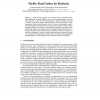Free Online Productivity Tools
i2Speak
i2Symbol
i2OCR
iTex2Img
iWeb2Print
iWeb2Shot
i2Type
iPdf2Split
iPdf2Merge
i2Bopomofo
i2Arabic
i2Style
i2Image
i2PDF
iLatex2Rtf
Sci2ools
RT
2001
Springer
2001
Springer
Thrifty Final Gather for Radiosity
Finite Element methods are well suited to the computation of the light distribution in mostly diffuse scenes, but the resulting mesh is often far from optimal to accurately represent illumination. Shadow boundaries are hard to capture in the mesh, and the illumination may contain artifacts due to light transports at different mesh hierarchy levels. To render a high quality image a costly final gather reconstruction step is usually done, which re-evaluates the illumination integral for each pixel. In this paper an algorithm is presented which significantly speeds up the final gather by exploiting spatial and directional coherence information taken from the radiosity solution. Senders are classified, so that their contribution to a pixel is either interpolated from the radiosity solution or recomputed with an appropriate number of new samples. By interpolating this sampling pattern over the radiosity mesh, continuous solutions are obtained.
| Added | 30 Jul 2010 |
| Updated | 30 Jul 2010 |
| Type | Conference |
| Year | 2001 |
| Where | RT |
| Authors | Annette Scheel, Marc Stamminger, Hans-Peter Seidel |
Comments (0)

